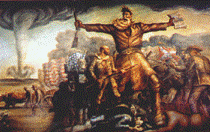History, Department of

James A. Rawley Graduate Conference in the Humanities
Date of this Version
April 2007
Document Type
Article
Abstract
When South Dakota and North Dakota became states in 1889, the powers that be split the old Dakota Territory lengthwise a few degrees south of the 46th parallel, creating two states that each spanned roughly 400 miles east to west, and about 230 miles north to south. The Missouri River ran through the central portion of both states, marking the approximate location of the 100th Meridian. Given the stark differences in annual moisture on either side of the Meridian and the inherent contrasts this discrepancy produces, perhaps these states should have been divided north to south instead.
In South Dakota, the “West River” half of the state trailed behind the east in settlement, economic development, and urbanization. While homesteaders and town-builders poured into the “East River” counties in the last decades of the nineteenth century, the west remained largely unsettled. The differences in settlement patterns in the two halves of the state produced two distinct regions—one east of the Missouri, the other west of the river. The “West River” region featured an environment, geography, and topography far different from the east, which contributed to its image as a unique region. This paper will explore the role of environment and settlement in South Dakota’s western half, and demonstrate how these factors helped settlers visualize “West River” as a unique region.


Comments
Paper presented at The Second Annual James A. Rawley Conference in the Humanities: Constructing Virtue, Making Place: Regional Creation in a National Context. April 7, 2007. University of Nebraska–Lincoln. Copyright (c) 2007 Nathan Sanderson.
This paper received the "Best Graduate Student Paper" Award at the 2007 James A. Rawley Graduate Conference in the Humanities.